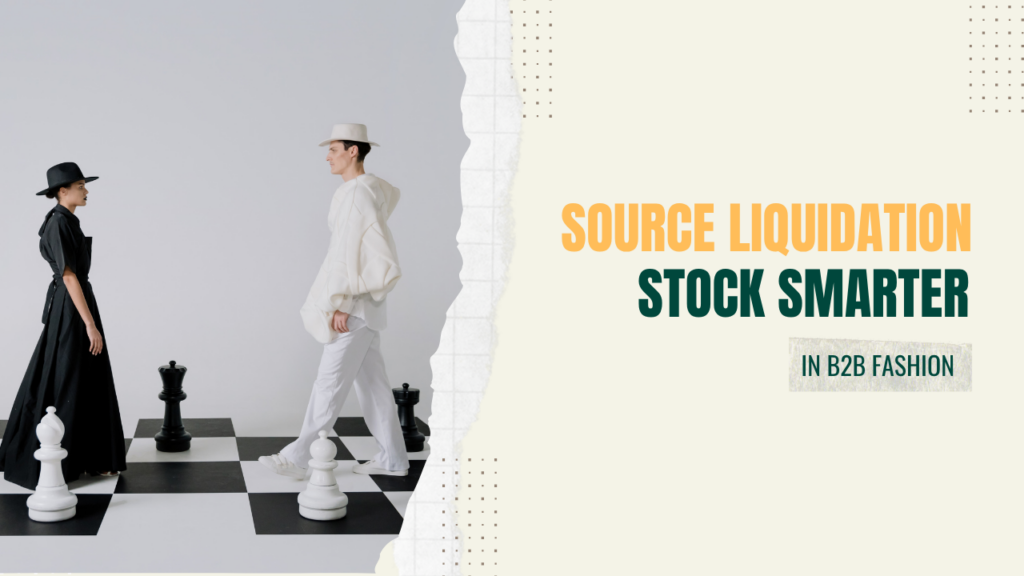Source Liquidation Stock Smarter in B2B Fashion
01 August 2025

01 August 2025

Source liquidation stock the smart way – without chasing unreliable vendors.
If you’re a fashion buyer, outlet operator or B2B e-commerce seller – you don’t need another dead-end marketplace. You need access, speed and structure.
This guide breaks down how to source branded liquidation inventory with precision, not luck, and how Take Off makes it easy for high-volume buyers to stay stocked with premium goods – sorted your way.
Liquidation stock refers to excess, unsold or cancelled inventory that brands release after retail cycles end. It might include last-season collections, overproduction or stock reserved for cancelled wholesale orders. While some still associate “liquidation” with low-grade goods or mystery boxes, that view is long outdated.
Today’s premium liquidation buyers expect:
You’re not just buying product. You’re buying reliability, margin and speed.
Smart sourcing starts with knowing the difference between stock types:
True liquidation is resale gold – if sourced correctly. And that’s where most platforms fall short.
For professional B2B buyers, sourcing shouldn’t feel like playing roulette. Yet many liquidation platforms leave you with more risk than return. The most common issues are:
Even sourcing directly from manufacturers or grey-market channels brings risk – from compliance problems to repackaging nightmares.
Most marketplaces prioritize speed of sale, not buyer experience. That’s why fashion retailers need a structured sourcing partner, not just a platform.
Whether you’re sourcing for one boutique or managing intake for an international e-commerce operation, here’s what to demand from your liquidation supplier:
Working with Take Off means checking all these boxes and more.
For another take on how Take Off helps you access branded liquidation with clarity and metadata control, check out our breakdown in Surplus Fashion Stock: Source Smarter
Unlike drop-ship aggregators or auction-style marketplaces, Take Off is built for serious B2B buyers. Here’s what sets it apart:
Unlike trend-focused fashion hubs, Take Off doesn’t push “what’s hot.” Instead, we provide clean access to ready-to-move branded stock, built for planning, not guessing.
Need less than 500 pieces? Use Bundlex
Ordering 500+? Get tailored help here
Take Off is designed to support high-volume resellers, chains, and online operations with structure at every step. Here’s how it works:
For a deeper look at how we simplify wholesale fashion sourcing across Europe, have a look at our blog on exclusive European fashion distribution.
Our model is built to remove operational friction. Instead of a one-time transaction, you get a sourcing partnership – including inventory planning, cross-border logistics and regional volume management.
Liquidation stock isn’t just about cheap goods – it’s a core margin builder. Here’s why top resellers and outlets rely on structured liquidation sourcing:
According to McKinsey, the off‑price market is projected to expand five times faster than the full‑price fashion segment between 2025 and 2030, and within the EU it is expected to grow from approximately 11% of the total fashion market in 2021 to 12% in 2025.
Now is the perfect time for retailers to lock in a reliable source, while competition is still fragmented.
Here’s our deep-dive on how you can optimize your margins without cutting corners.
Master these 6 rules and you won’t just source liquidation stock – you’ll turn it into a long-term margin advantage for your fashion business.
Browse our full blog archive for insights into off-price fashion, wholesale trends and smart B2B sourcing strategies.
What is liquidation stock in fashion?
Liquidation stock refers to excess or unsold inventory sold off by brands, often at steep discounts.
Where can I buy branded liquidation stock in Europe?
Take Off offers direct access to over 250 brands – with warehousing, logistics, and multilingual support.
How can I avoid low-quality liquidation lots?
Work only with verified distributors who provide HD product data, line sheets, and real brand sourcing.
Can I buy liquidation stock if I only want 300 pieces?
Yes – Bundlex is ideal for smaller stock under 500 pieces.
Do liquidation suppliers offer export documents?
Trusted B2B distributors like Take Off provide full manifests, invoices, and repackaging services.
What’s the difference between liquidation and clearance stock?
Liquidation comes from brands offloading excess inventory. Clearance is usually a B2C retail markdown.